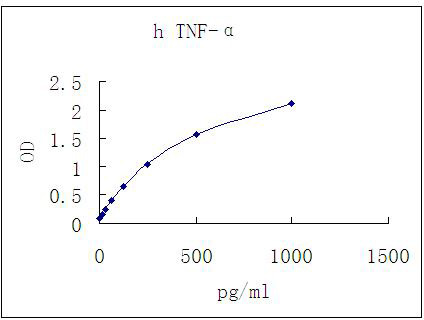Human TNF-a ELISA Kit (48-well)
USD 290.00
3 Weeks*
Specifications
| Product Data | |
| Format | 48-well strip plate |
| Assay Type | Solid Phase Sandwich ELISA |
| Assay Length | 3 hours |
| Signal | Colorimetric |
| Curve Range | 15.625-1000pg/ml |
| Sample Type | Cell culture supernatant, serum, plasma (EDTA, citrate, heparin) |
| Sample Volume | 20 uL |
| Specificity | Natural and recombinant Human TNF-a Ligand |
| Sensitivity | 7pg/mL |
| Reactivities | Human |
| Interference | No significant interference observed with available related molecules. |
| Components |
|
| Background | The prototype ligand of the TNF superfamily, TNF-./TNFSF1A, is a pleiotropic cytokine that plays a central role in inflammation and apoptosis . Human cells known to express TNF-. include B cells, colonic columnar epithelial cells, NK and CD3+CD56+ hepatic natural T cells, macrophages, monocytes and monocyte-derived dendritic cells, CD4+ and CD8+ T cells, mast cells, neutrophils, keratinocytes, plasma cells, and adipocytes. It is synthesized as a 26 kDa, type II transmembrane protein that is 233 amino acids (aa) in length . It contains a 30 aa cytoplasmic domain, a 26 aa transmembrane segment, and a 177 aa extracellular region . TNF-. is assembled intracellularly to form a transmembrane, non-covalently-linked homotrimeric protein. The 157 aa residue soluble form of TNF-. (sTNF-. is released from the C-terminus of the transmembrane protein through the activity of TNF-.-converting enzyme (TACE), a membrane-bound disintegrin metalloproteinase . TNF-. is reported to promote inflammatory cell infiltration by upregulating leukocyte adhesion molecules on endothelial cells, serve as a chemotactic agent for monocytes, and activate phagocyte killing mechanisms . Deficiencies in either TNF-. or its receptors can increase susceptibility to infection by intracellular pathogens . TNF- may also play a role in lymphoid tissue development. Knockout mice lack splenic B cell follicles and the ability to form germinal centers . Other potential physiological roles for TNF-. and its receptors include regulating the differentiation of hematopoietic stem and progenitor cells . TNF-. has been implicated in a number of pathophysiological processes. It is associated with unregulated pro-inflammatory activity and is thought to be a critical mediator of endotoxin-induced septic shock . Cachexia (or whole body wasting) has also been associated with long-term circulating TNF-.. Other disorders with potential TNF-. involvement include asthma), type 2 diabetes, CrohnÂ?s disease, and rheumatoid arthritis. |
| Gene Symbol | TNF |
| Standard Curve |

Representative standard curve for TNF-a ELISA.TNF-a was diluted in serial two-fold steps in Sample Diluent.
|
Documents
{0} Product Review(s)
Be the first one to submit a review






























































































































































































































































 Germany
Germany
 Japan
Japan
 United Kingdom
United Kingdom
 China
China